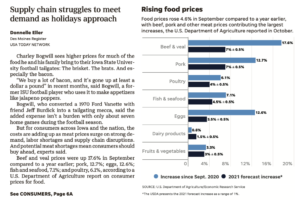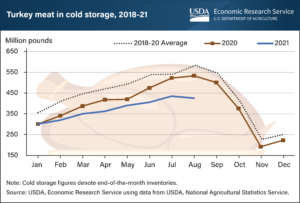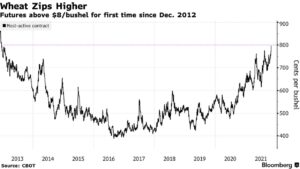Beef prices are projected to continue increasing as U.S. beef production declines with no signs of a cattle herd rebuild. Additionally, cheap beef may soon become further out of reach…
Supply-Chain Issues Persist at Supermarkets as Meat Prices Rise- Turkey Availability a Concern
Wall Street Journal writer Jaewon Kang reported earlier this week that, “Supermarket chains are revamping their operations to navigate persistent product shortages, expanding storage space and curbing discounts to make sure they don’t run out.
“Companies are planning for shortages of popular brands of food and staples to continue for months and managers are trying to keep up as different products run short from week to week, industry executives said. While food supplies overall remain plentiful, Nutella spread, Prego pasta sauces and Pringles chips are among many items that have been tough to secure in recent weeks, some supermarket companies said. Lunchables snacks and Capri Sun drinks have been hit-or-miss for months.
‘The fact is, it’s like whack-a-mole,’ Vivek Sankaran, chief executive of Albertsons Cos., said on a conference call recently. ‘On any given day, something is out of stock in the store.’
The Journal article stated that, “Some packaged-food makers, struggling with stretched staffing and hard-to-find raw materials, are limiting shipments of products, companies said. In response, grocery buyers, who are in charge of planning and coordinating orders, are spending more time tracking down vendors, managing trucks that arrive late and searching for substitutes for out-of-stock items. Food retailers are buying extra inventory whenever they can, ordering items months earlier than usual and sending their own trucks directly to manufacturing plants to make pickups and speed up delivery times.”
Meanwhile, Donnelle Eller reported on the front page of Monday’s Des Moines Register that, “Beef and veal prices were up 17.6% in September compared to a year earlier; pork, 12.7%; eggs, 12.6%; fish and seafood, 7.1%; and poultry, 6.1%, according to a U.S. Department of Agriculture report on consumer prices for food.”

“For 2021 alone, the agriculture department expects beef, veal and pork prices to climb 6.5% to 7.5%; poultry prices to jump 3.5% to 4.5%; and egg prices 3% to 4%,” the Register article said.
Ms. Eller added that, “The agriculture department said in October that extreme and exceptional drought in the western U.S. had impacted 45% of the nation’s alfalfa hay and would likely push prices higher for beef and dairy producers.”
Monday’s article explained that, “Disruptions are occurring across the supply chain — from labor shortages at farms, meatpacking plants, warehouses and ports to shortages of aluminum, plastics and other packaging materials, said Jennifer Blackhurst, a University of Iowa professor of business analytics.
“‘Put it all together, and it’s causing prices to go up,’ she said.”
In a separate Des Moines Register article this week, Donnelle Eller reported that, “You’ve been warned: If you’re supplying the turkey for this year’s Thanksgiving gathering, buy it now.
‘It’s inevitable. Some stores will run out of turkeys,’ said Joe Kerns, president of Partners for Production Agriculture, a commodity risk management company in Ames.
“Here’s why: Turkey production is down year-over-year, the U.S. Department of Agriculture department said in October. The supply of birds in cold storage through August, the end of the seasonal buildup to the holiday, was 20% below the same time a year earlier.”

In other market news, Bloomberg writer’s Kim Chipman and Megan Durisin reported on Monday that, “Benchmark wheat in Chicago climbed above $8 a bushel for the first time in almost nine years as importers boost purchases amid adverse weather conditions and soaring fertilizer prices that risk denting next year’s harvests.
“The advance may ramp up already high food costs worldwide. Futures tied to other types of wheat also surged amid increasing demand and dwindling reserves due to inclement weather.

“Some farmers are now contending with dry soil at planting time, as well as a run up in fertilizer prices. Wheat is on its longest streak of monthly gains since 2007.”

The Bloomberg article added that, “The world’s largest phosphate producer, Mosaic Co., said it expects fertilizer prices to continue surging.”
And Dow Jones writer Kirk Maltais reported on Monday that, “Not only are prices for fertilizer much higher than last year, farmers say that they are having difficulty being able to purchase any at all because of delays and issues with the global supply chain.
“According to John Dittrich, a farmer in Tilden, Neb., prices keep rising and suppliers are having issues keeping up. ‘I’m not even sure I could get a price today,’ he said.
“Mr. Dittrich adds that he has booked all of his fertilizer needs for 2022 already, with his cost for nitrogen fertilizer being triple what he paid last year and phosphate fertilizer costing double.
“However, for farmers that have yet to book, prices keep rising and available supply looks scarce.”





